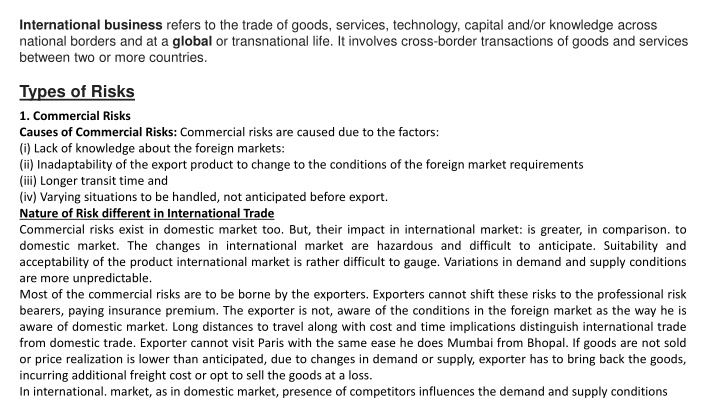
International Business Risks and Management
Explore the various types of risks involved in international business, such as commercial, political, legal, cargo, and credit risks. Learn how exporters navigate these challenges to ensure successful cross-border transactions. Gain insights into the impact of global market changes and competitors on trade dynamics. Stay informed on risk mitigation strategies and tools to manage uncertainties in the international business landscape.
Download Presentation

Please find below an Image/Link to download the presentation.
The content on the website is provided AS IS for your information and personal use only. It may not be sold, licensed, or shared on other websites without obtaining consent from the author. If you encounter any issues during the download, it is possible that the publisher has removed the file from their server.
You are allowed to download the files provided on this website for personal or commercial use, subject to the condition that they are used lawfully. All files are the property of their respective owners.
The content on the website is provided AS IS for your information and personal use only. It may not be sold, licensed, or shared on other websites without obtaining consent from the author.
E N D
Presentation Transcript
International business refers to the trade of goods, services, technology, capital and/or knowledge across national borders and at a global or transnational life. It involves cross-border transactions of goods and services between two or more countries. Types of Risks 1. Commercial Risks Causes of Commercial Risks: Commercial risks are caused due to the factors: (i) Lack of knowledge about the foreign markets: (ii) Inadaptability of the export product to change to the conditions of the foreign market requirements (iii) Longer transit time and (iv) Varying situations to be handled, not anticipated before export. Nature of Risk different in International Trade Commercial risks exist in domestic market too. But, their impact in international market: is greater, in comparison. to domestic market. The changes in international market are hazardous and difficult to anticipate. Suitability and acceptability of the product international market is rather difficult to gauge. Variations in demand and supply conditions are more unpredictable. Most of the commercial risks are to be borne by the exporters. Exporters cannot shift these risks to the professional risk bearers, paying insurance premium. The exporter is not, aware of the conditions in the foreign market as the way he is aware of domestic market. Long distances to travel along with cost and time implications distinguish international trade from domestic trade. Exporter cannot visit Paris with the same ease he does Mumbai from Bhopal. If goods are not sold or price realization is lower than anticipated, due to changes in demand or supply, exporter has to bring back the goods, incurring additional freight cost or opt to sell the goods at a loss. In international. market, as in domestic market, presence of competitors influences the demand and supply conditions
and entry of new competitors depresses the market more. Further, local production may bring down the prices. Introduction of substitutes to capture the market may take away the exporter's share in the market. 2. Political Risks:-These risks arise due to change in political situations in the concerned importing and exporting countries. Following are the factors, affecting the political situation: (i) Changes in the party in power in the concerned countries, followed by 1 head of the Government; (ii) Coups, civil wars and rebellions: (iii) Wars between the countries or among- many countries and (iv) Capture of cargo by enemies during war. Political risks can be avoided, to a certain extent, by judicious selection of the countries to which goods are exported. Insurance companies may agree to provide cover for some of these risks, by collecting additional premium. Export Credit. Guarantee Corporation (ECGC.) also 'covers seine of the risks. 3. Risks Arising out of Foreign Laws (Legal Risks) Every country has its own commercial law. So, different laws prevail both in exporter and importer countries. Legal proceedings are complex as well as expensive. In every relationship, however cordial and long-standing may be, differences are likely to arise. Legal risks can be avoided to a great extent by incorporating the provision for appointment of an arbitrator, in case of dispute about contractual terms. 4. Cargo risks Transportation of cargo has undergone radical improvements over a period. Most of the goods are transported by sea. Transit risks are a common hazard for those engaged in export/import business. The list of dreary and hazardous risks in transit is long viz. Storms, collisions, theft, leakage, explosion, spoilage, fire, and high sea robbery. Every exporter should have working knowledge of marine insurance so that he knows whether he is getting the required risk protection at the minimum cost, It is always possible to transfer the financial losses resulting from perils of sea and perils in transit to professional risk bearers known as underwriters Principles of marine insurance are also equally applicable to insurance of air cargo also. 5. Credit Risks, Risks are inherent in credit transactions; more so in international business. International business is
invariably riskier than the domestic trade. Credit risk. is not the same whether one sells the goods in domestic market or in foreign market. Success, in international business depends, largely, on the ability of the exporters to give credit to importers on the competitive and favorable terms. Meaning of Credit Risk Once goods are sold on credit risks arising in realizing the sale proceeds are referred as credit risks. Risk may arise due to inability of the buyers to pay on the due date. Alternatively, even if the buyer makes the payment, situations may change in the buyer's country that the funds of 'buyer do not reach the exporter. An outbreak of war, civil war, coup or an insurrection may block or delay the payment for goods exported. Whatever the reason may be, if funds are not received, sufferer is, finally, exporter. Credit risk has assumed an alarming proportion on account of large volumes in international business and sweeping changes in political and economic conditions, globally. In such a high risky situation, credit risk insurance is of immense help to the exporters as well as banks that finance the exporters. 6, Foreign Exchange Fluctuations Risks If the exporter has invoiced in the buyer's currency, he will be subjected to risk of foreign exchange fluctuations. If the foreign currency depreciates in terms of rupees, exporter will receive lesser amount in terms of rupees or vice versa. In the same circumstances, if the Indian currency depreciates, exporter stands to gain. If the export, bill is purchased or negotiated under letter of credit and the foreign currency undergoes fluctuation, the bank will be bearing the risk. However, if the exporter has sent the bill for collection, the exchange rate on the date of receipt of foreign currency in India will be given to the exporter. If there is intervening difference in the exchange rate between the date of giving the bill for collection and date of realization, exporter stands to lose or gain, depending on the trend in fluctuation. There will be no foreign exchange risk in case the invoice is made in Indian rupees. In such a case, the importer will be subjected to foreign exchange fluctuation risk.
The Stages of Internationalization Stage 1: Domestic Operations The firm s market is exclusively domestic. Stage 2: Export Operations The firm expands its market to include other countries, but retains production facilities within domestic borders. Stage 3: Subsidiaries or Joint Ventures The firm physically moves some of its operations out of the home country. Stage 4: Multinational Operations The firm becomes a full-fledged multinational corp. (MNC) with assembly and production facilities in several countries and regions of the world. Some decentralization of decision making is common, but many personnel decisions are still made at corp. headquarters. Stage 5: Transnational Operations Firms that reach this stage are often called transna- tional because they owe little allegiance to their country of origin. Operations are highly decentralized, with each busi-ness unit free to make personnel decisions with very loose control from corp. headquarters.
Modes of Entry into International Business [Advantages & Disadvantages] 1. Direct Exporting Direct exporting involves you directly exporting your goods and products to another overseas market. For some businesses, it is the fastest mode of entry into the international business. Advantages of Direct Exporting You can select your foreign representatives in the overseas market. You can utilize the direct exporting strategy to test your products in international markets before making a bigger investment in the overseas market. This strategy helps you to protect your patents, goodwill, trademarks and other intangible assets. 2. Licensing and Franchising Companies which want to establish a retail presence in an overseas market with minimal risk, the licensing and franchising strategy allows another person or business assume the risk on behalf of the company. In Licensing agreement and franchise, an overseas-based business will pay you a royalty or commission to use your brand name, manufacturing process, products, trademarks and other intellectual properties. While the licensee or the franchisee assumes the risks and bears all losses, it shares a proportion of their revenues and profits you. 3. Joint Ventures A joint venture is one of the preferred modes of entry into international business for businesses who do not mind sharing their brand, knowledge, and expertise. Companies wishing to expand into overseas markets can form joint ventures with local businesses in the overseas location, wherein both joint venture partners share the rewards and risks associated with the business. Both business entities share the investment, costs, profits and losses at the predetermined proportion.
This mode of entry into international business is suitable in countries wherein the governments do not allow one hundred per cent foreign ownership in certain industries. For instance, foreign companies cannot have a 100 hundred per cent stake in broadcast content services, print media, multi- brand retailing, insurance, power exchange sectors and require to opt for a joint-venture route to enter the Indian market. 4. Strategic Acquisitions Strategic acquisition implies that your company acquires a controlling interest in an existing company in the overseas market. This acquired company can be directly or indirectly involved in offering similar products or services in the overseas market. You can retain the existing management of the newly acquired company to benefit from their expertise, knowledge and experience while having your team members positioned in the board of the company as well. 5. Foreign Direct Investment Foreign Direct Investment involves a company entering an overseas market by making a substantial investment in the country. Some of the modes of entry into international business using the foreign direct investment strategy includes mergers and acquisitions, joint ventures and greenfield investments. This strategy is viable when the demand or the size of the market, or the growth potential of the market in the substantially large to justify the investment. Some of the reasons because of which companies opt for foreign direct investment strategy as the mode of entry into international business can include: Restriction or import limits on certain goods and products. Manufacturing locally can avoid import duties. Companies can take advantage of low-cost labour, cheaper material. Globalisation:-
Globalization or globalisation is the process of interaction and integration among people, companies, and governments worldwide. ... Globalization has grown due to advances in transportation and communication technology. With the increased global interactions comes the growth of international trade, ideas, and culture. Reasons for globalisation There are several key factors which have influenced the process of globalisation: Improvements in transportation - larger cargo ships mean that the cost of transporting goods between countries has decreased. Economies of scale mean the cost per item can reduce when operating on a larger scale. Transport improvements also mean that goods and people can travel more quickly. Freedom of trade - organisations like the World Trade Organisation (WTO) promote free trade between countries, which help to remove barriers between countries. Improvements of communications - the internet and mobile technology have allowed greater communication between people in different countries. Labour availability and skills - countries such as India have lower labour costs (about a third of that of the UK) and also high skill levels. Labour intensive industries such as clothing can take advantage of cheaper labour costs and reduced legal restrictions in LEDCs. The advantages of globalization for business 1. Ability to tap into a wider talent pool When fully taking advantage of globalization, you are no longer restrained by talent that is available in your city. Today your global workforce could work from anywhere in the world with an internet connection opening you up to the brightest and best candidates the entire world has to offer.
2. New ideas due to cultural diversity Managing an international workforce includes teams working across different locations, people traveling and moving countries for work, having a range of different work ethics and practices and even religious differences. All of these can be challenges, but overwhelmingly are a positive thing in the workplace as it brings together different ideas and insights and perspectives. 3. Larger markets Globalization opens up new opportunities for businesses to sell their goods and services to a much larger markets, which means more potential sales and greater profits. Depending on the organization it can open up other opportunities in terms of distribution, logistics, marketing and management of these goods and services. 4. Earnings changes With more and more companies accessing overseas outsourcing opportunities, wages have decreased for many workers in the original countries. Companies in the developing world are able to offer their services at a much reduced rate from those who live in countries with greater living standards. This means that workers in larger countries are affected. For businesses looking to take advantage of the opportunities offered by globalization, this can include paying lower salaries and having lower overheads when they operate in less developed nations. Other savings can be made in countries that have more favorable taxation and reduced red tape and business costs. The disadvantages of globalization for business 1. Potential for IP theft When products are built overseas in factories on behalf of a company based in another country, there is potential that intellectual property and designs could be copied and stolen and replicated and sold for cheaper elsewhere.
2. Issues with supply chain Businesses committed to ethical work practices may find that they cannot always account for these standards being met at every point in their supply chain and operations. For example there may be suppliers, farmers, factory workers, logistics operators who are exploited or work in unsafe conditions. 3. Corruption Different standards apply in different countries, and many nations in the developing world are rife with corruption. Researchers at the Henley Business School found 85% of managers surveyed admitted they had to resort to bribery when trading with developing countries where it is considered a usual cost of doing business. 4. Threat to agriculture Globalisation is also posing as a threat to agriculture in developing and underdeveloped countries of the world. As with the WTO trading provisions, agricultural commodities market of poor and developing countries will be flooded farm goods from countries at a rate much lower than that indigenous farm products leading to a death-blow to many farmers. 5.Lack of Cooperation of people for change Implementation of globalisation principle becoming harder in many industrially developed democratic countries to ask its people to bear the pains and uncertainties of structural adjustment with the hope of getting benefits in future. Foreign Investment Foreign Investment refers to investment by foreign investors in shares, debentures, bonds of other nations companies. There are two kinds of foreign investment:- 1. Foreign Direct Investment 2. Portfolio Investment
Foreign Direct Investment:- FDI is made by foreign companies in order toestablish wholly owned companies in another country and to manage them or to purchase shares of companies in another country for the purpose of managing such companies. The main feature of FDI is that native companies are managed by the foreign companies. Portfolio Investment:- Under this type of investment, foreign companies buy shares/debentures of native companies, however management and control remain vested with the native companies themselves. Factors that affect foreign direct investment (FDI) 1. Wage rates A major incentive for a multinational to invest abroad is to outsource labour-intensive production to countries with lower wages. If average wages in the US are $15 an hour, but $1 an hour in the Indian sub-continent, costs can be reduced by outsourcing production. This is why many Western firms have invested in clothing factories in the Indian sub-continent. However, wage rates alone do not determine FDI, countries with high wage rates can still attract higher tech investment. A firm may be reluctant to invest in Sub-Saharan Africa because low wages are outweighed by other drawbacks, such as lack of infrastructure and transport links. 2. Labour skills Some industries require higher skilled labour, for example pharmaceuticals and electronics. Therefore, multinationals will invest in those countries with a combination of low wages, but high labour productivity and skills. For example, India has attracted significant investment in call centres, because a high percentage of the population speak English, but wages are low. This makes it an attractive place for outsourcing and therefore attracts investment.
3. Tax rates Large multinationals, such as Apple, Google and Microsoft have sought to invest in countries with lower corporation tax rates. For example, Ireland has been successful in attracting investment from Google and Microsoft. In fact, it has been controversial because Google has tried to funnel all profits through Ireland, despite having operations in all European countries. 4. Transport and infrastructure A key factor in the desirability of investment are the transport costs and levels of infrastructure. A country may have low labour costs, but if there is then high transport costs to get the goods onto the world market, this is a drawback. Countries with access to the sea are at an advantage to landlocked countries, who will have higher costs to ship goods. 5. Size of economy / potential for growth Foreign direct investment is often targeted to selling goods directly to the country involved in attracting the investment. Therefore, the size of the population and scope for economic growth will be important for attracting investment. For example, Eastern European countries, with a large population, e.g. Poland offers scope for new markets. This may attract foreign car firms, e.g. Volkswagen, Fiat to invest and build factories in Poland to sell to the growing consumer class. Small countries may be at a disadvantage because it is not worth investing for a small population. China will be a target for foreign investment as the newly emerging Chinese middle class could have a very strong demand for the goods and services of multinationals. 6. Political stability / property rights Foreign direct investment has an element of risk. Countries with an uncertain political situation, will be a major disincentive. Also, economic crisis can discourage investment. For example, the recent Russian economic crisis, combined with economic sanctions, will be a major factor to discourage foreign investment. This is one reason why former Communist countries in the East are keen to join the European Union. The EU is seen as a signal of political and economic stability, which encourages foreign investment. 7. Commodities One reason for foreign investment is the existence of commodities. This has been a major reason for the growth in FDI
within Africa often by Chinese firms looking for a secure supply of commodities. 8. Exchange rate A weak exchange rate in the host country can attract more FDI because it will be cheaper for the multinational to purchase assets. However, exchange rate volatility could discourage investment. 9. Clustering effects Foreign firms often are attracted to invest in similar areas to existing FDI. The reason is that they can benefit from external economies of scale growth of service industries and transport links. Also, there will be greater confidence to invest in areas with a good track record. Therefore, some countries can create a virtuous cycle of attracting investment and then these initial investments attracting more. It is also sometimes known as an agglomeration effect. 10. Access to free trade areas. A significant factor for firms investing in Europe is access to EU Single Market, which is a free trade area but also has very low non-tariff barriers because of harmonisation of rules, regulations and free movement of people. For example, UK post-Brexit is likely to be less attractive to FDI, if it is outside the Single Market. Advantages of FDI for Host Nation 1. Increased Employment and Economic Growth Creation of jobs is the most obvious advantage of FDI. It is also one of the most important reasons why a nation, especially a developing one, looks to attract FDI. Increased FDI boosts the manufacturing as well as the services sector. This in turn creates jobs, and helps reduce unemployment among the educated youth - as well as skilled and unskilled labour - in the country. Increased employment translates to increased incomes, and equips the population with enhanced buying power. This boosts the economy of the country.
2. Human Resource Development This is one of the less obvious advantages of FDI. Hence, it is often understated. Human Capital refers to the knowledge and competence of the workforce. Skills gained and enhanced through training and experience boost the education and human capital quotient of the country. Once developed, human capital is mobile. It can train human resources in other companies, thereby creating a ripple effect. 3. Development of Backward Areas This is one of the most crucial benefits of FDI for a developing country. FDI enables the transformation of backward areas in a country into industrial centres. This in turn provides a boost to the social economy of the area. The Hyundai unit at Sriperumbudur, Tamil Nadu in India exemplifies this process. 4. Provision of Finance & Technology Recipient businesses get access to latest financing tools, technologies and operational practices from across the world. Over time, the introduction of newer, enhanced technologies and processes results in their diffusion into the local economy, resulting in enhanced efficiency and effectiveness of the industry. 5. Increase in Exports Not all goods produced through FDI are meant for domestic consumption. Many of these products have global markets. The creation of 100% Export Oriented Units and Economic Zones have further assisted FDI investors in boosting their exports from other countries. 6. Exchange Rate Stability The constant flow of FDI into a country translates into a continuous flow of foreign exchange. This helps the country s Central Bank maintain a comfortable reserve of foreign exchange. This in turn ensures stable exchange rates. 7. Stimulation of Economic Development This is another very important advantage of FDI. FDI is a source of external capital and higher revenues for a country. When factories are constructed, at least some local labour, materials and equipment are utilised. Once the construction is complete, the factory will employ some local employees and further use local materials and services. The people who are employed by
such factories thus have more money to spend. This creates more jobs. 8. Improved Capital Flow Inflow of capital is particularly beneficial for countries with limited domestic resources, as well as for nations with restricted opportunities to raise funds in global capital markets. 9. Creation of a Competitive Market By facilitating the entry of foreign organisations into the domestic marketplace, FDI helps create a competitive environment, as well as break domestic monopolies. A healthy competitive environment pushes firms to continuously enhance their processes and product offerings, thereby fostering innovation. Consumers also gain access to a wider range of competitively priced products. Disadvantages of FDI for Host Nation Disappearance of cottage and small scale industries: Some of the products produced in cottage and village industries and also under small scale industries had to disappear from the market due to the onslaught of the products coming from FDIs. Example: Multinational soft drinks. Contribution to the pollution: Foreign direct investments contribute to pollution problem in the country. The developed countries have shifted some of their pollution-borne industries to the developing countries. The major victim is automobile industries. Most of these are shifted to developing countries and thus they have escaped pollution. Exchange crisis: Foreign Direct Investments are one of the reason for exchange crisis at times. During the year 2000, the Southeast Asian countries experienced currency crisis because of the presence of FDls. With inflation contributed by them, exports have dwindled resulting in heavy fall in thevalue of domestic currency.
As a result of this, the FDIs started withdrawing their capital leading to an exchange crisis. Thus, too much dependence on FDls will create exchange crisis. Cultural erosion: In all the countries where the FDls have made an inroad, there has been a cultural shock experienced by the local people, adopting a different culture alien to the country. The domestic culture either disappears or suffers a setback. This is felt in the family structure, social setup and erosion in the value system of the people. Importance given to human relations, hither to suffers a setback with the hi-fi style of living. Political corruption: In order to capture the foreign market, the FDIs have gone to the extent of even corrupting the high officials or the political bosses in various countries. Lockheed scandal of Japan is an example. In certain countries, the FDIs influence the political setup for achieving their personal gains. Most of the Latin American countries have experienced such a problem. Example: Drug trafficking, laundering of money, etc. Inflation in the Economy: The presence of FDIs has also contributed to the inflation in the country. They spend lot of money on advertisement and on consumer promotion. This is done at the cost of the consumers and the price is increased. They also form cartels to control the market and exploit the consumer. The biggest world cartel, OPEC is an example of FDI exploiting the consumers. Trade Deficit: The introduction of TRIPs (Trade Related Intellectual Property Rights) and TRIMs (Trade Related Investment Measures) has restricted the production of certain products in other countries. For example, India cannot manufacture certain medicines without paying royalties to the country which has originally invented the medicine. The same thing applies to seeds which are used in agriculture. Thus, the developing countries are made to either import the products or produce them through FDIs at a higher cost. WTO (World Trade Organization) is in favor of FDIs. World Bank and lMF Aid: Some of the developing countries have criticized the World Bank and IMF (International Monetary Fund) in extending assistance.
There is a discrimination shown by these international agencies. Only those countries which accommodate FDIs will receive more assistance from these international institutions. Convertibility of Currency: FDIs are insisting on total convertibility of currencies in under-developed countries as a prerequisite for investment. This may not be possible in many countries as there may not be sufficient foreign currency reserve to accommodate convertibility. In the absence of such a facility, it is dangerous to allow the FDIs as they may withdraw their investments the moment they find their investments unprofitable. Advantages of FDI for Home Nation 1. It provides local economic benefits in multiple locations. The companies or individuals that participate in FDI can stimulate community economic growth on the local level for their headquarters or home. Profits are often reinvested into workers or increasing organizational opportunities, which can create new jobs, which then creates new FDI opportunities. The investments do the same for the home market of the foreign organization as well. 2. It makes international trade easier to complete. Many countries have import tariffs that must be paid for goods and services. Import/Export businesses can struggle to keep products at affordable prices for customers because of these taxes. Through FDI, it becomes possible to limit or eliminate these tariffs since a minimum stake in a foreign organization occurs. That gives the local business more control over the market while maintaining price competition.
3. Foreign income can increase. Many foreign markets have employees working at wages that would be considered poverty wages in the United States. A majority of the world earns less than $4 per hour. Some international markets offer less than $1 per hour. With FDI, foreign income levels can increase. Worker wages increase. That creates new resources that can help communities to begin growing. 4. It improves human resources. Businesses are successful because humans have expertise. In the under-developed and developing world, human skills are limited to basic labor, agricultural work, and other entry-level skills. Foreign direct investment creates educational opportunities so that people can improve their personal skill base. With better skills, higher wages can be earned. Greater productivity levels are achieved. The company benefits, as does the individual, and that trickles down to each community. 5. It allows your money to work harder for you. To encourage FDI, many governments have placed tax incentives on this type of investment. That makes more money available to work for a foreign company without disrupting the investing agency s budget dramatically. These incentives make it easier to accomplish goals because the money involved can be directed toward resources instead of government coffers. At the same time, the gap between cost and revenue is reduced, providing more opportunities to find profit streams. 6. It provides a foreign company with needed experience. Investors bring more than money to an FDI relationship. They can also bring their personal experiences within a specific industry. For the foreign company, such an investment can create an immediate surge in productivity. Investments can also provide better facilities for the foreign organization, better equipment assets, and improved vendor access if contact access from the investor is permitted in the relationship. 7. It creates new opportunities for workers. Workers who are employed by the investing company can travel overseas and experience new cultures and ideas. That can make them more productive at home. Foreign workers have better access to the
them to create new opportunities as well. This process helps both parties grow faster than if they were on their own. Disadvantages of Foreign Direct Investment for Home Nation 1. It stops domestic investments from happening. A 10% minimum investment into a foreign company is money that isn t going into domestic companies. Although money comes back into local communities with FDI, a local investment s value is almost another $1 for every dollar spent. That means a $10,000 domestic investment could be worth $20,000 or more in the future. 2. It isn t without risk. Political instability around the world means that the business environment can change at a moment s notice. Although companies and individuals choose foreign organizations that have little risk, there can never be a complete elimination of risk from the transaction. In some countries, the political risk factors could be so high that a foreign direct investment doesn t make sense. 3. It can be more expensive. In the United States, the dollar is one of the strongest currencies in the world. For an investment into the developing world, the value of the currency can be stretched further than it would be domestically. That isn t always the case, however, because the euro and the pound trade higher than the dollar. Investing into one of those markets through FDI would actually have higher costs for the individual or business compared to a domestic investment. 4. It can affect currency exchange rates. A developing country with a struggling currency may see a surge of popularity after a foreign direct investment. People and companies see an investment as a sign of stability, creating additional interest in the market being examined. That higher level of interest can lead to a better monetary value for the foreign nation, which may destabilize exchange rates. 5. It can lead to exploitation. Exploitation of FDI can happen on a number of levels. A foreign government might choose to seize the investment. Assets or proprietary information might be seized for political purposes. The foreign company might take the investment and squander it.
Even if there is a well-constructed contract governing the terms and conditions of the investment, some foreign companies may decide to take the money and run. That can leave an investor with few, if any, options to recover their funds. Foreign Exchange And Exchange Rate Foreign Exchange:- Foreign exchange, or forex, is the conversion of one country's currency into another. Foreign Exchange Market: Meaning: Foreign exchange market is the market in which foreign currencies are bought and sold. The buyers and sellers include individuals, firms, foreign exchange brokers, commercial banks and the central bank. Definition of 'Exchange Rate' Definition: Exchange rate is the price of one currency in terms of another currency. TYPES OF EXCHANGE RATES FIXED EXCHANGE RATE A fixed exchange rate, also known as the pegged exchange rate, is pegged or linked to another currency or asset (often gold) to derive its value. Such an exchange rate mechanism ensures the stability of the exchange rates by linking it to a stable currency itself. Also, a fixed currency system is relatively well protected against the rapid fluctuations in inflation. Some countries following a fixed rate system include Denmark, Hong Kong, Bahamas & Saudi Arabia.
Advantage: A country with a fixed exchange rate system is attractive to foreign investors who are lured to invest in that country due to the stability it offers. Disadvantage: The government of a country following such a system has to maintain a huge amount of foreign exchange or gold reserves to maintain its value. This system thus proves to be an expensive one. FLEXIBLE EXCHANGE RATE Flexible or Floating exchange rate systems are ones whereby the rate of a currency is determined by the market forces of demand and supply. Unlike the fixed exchange rate they do not derive their value from any underlying. Some economists argue that a floating system is more preferable since it absorbs the shocks of a global crisis and automatically adjusts to arrive at an equilibrium. The central bank of the country may interfere in economically extreme situations such as the recession or boom to stabilize the currency. They may buy or sell an amount of the currency to prevent the rates from going haywire. This phenomenon is known as the managed float. Advantage: The rates under this system are determined by a self-sufficient mechanism. Therefore, the dependence on government or international monetary organizations is minimum. Also, the determination of rate by the market forces of demand and supply promote efficiency and robustness of operations. Disadvantage: Floating rate systems are prone to greater volatility since they are determined by the market forces. The increased volatility increases the risk quotient in such markets consequently making it a relatively expensive place for the foreign investors. Factors Influencing Exchange Rate:-
1. Inflation Rates Changes in market inflation cause changes in currency exchange rates. A country with a lower inflation rate than another's will see an appreciation in the value of its currency. The prices of goods and services increase at a slower rate where the inflation is low. A country with a consistently lower inflation rate exhibits a rising currency value while a country with higher inflation typically sees depreciation in its currency and is usually accompanied by higher interest rates 2. Interest Rates Changes in interest rate affect currency value and dollar exchange rate. Forex rates, interest rates, and inflation are all correlated. Increases in interest rates cause a country's currency to appreciate because higher interest rates provide higher rates to lenders, thereby attracting more foreign capital, which causes a rise in exchange rates 3. Country s Current Account / Balance of Payments A country s current account reflects balance of trade and earnings on foreign investment. It consists of total number of transactions including its exports, imports, debt, etc. A deficit in current account due to spending more of its currency on importing products than it is earning through sale of exports causes depreciation. Balance of payments fluctuates exchange rate of its domestic currency. 4. Government Debt Government debt is public debt or national debt owned by the central government. A country with government debt is less likely to acquire foreign capital, leading to inflation. Foreign investors will sell their bonds in the open market if the market predicts government debt within a certain country. As a result, a decrease in the value of its exchange rate will follow. 5. Terms of Trade Related to current accounts and balance of payments, the terms of trade is the ratio of export prices to import prices. A country's terms of trade improves if its exports prices rise at a greater rate than its imports prices. This results in higher revenue, which
causes a higher demand for the country's currency and an increase in its currency's value. This results in an appreciation of exchange rate. 6. Political Stability & Performance A country's political state and economic performance can affect its currency strength. A country with less risk for political turmoil is more attractive to foreign investors, as a result, drawing investment away from other countries with more political and economic stability. Increase in foreign capital, in turn, leads to an appreciation in the value of its domestic currency. A country with sound financial and trade policy does not give any room for uncertainty in value of its currency. But, a country prone to political confusions may see a depreciation in exchange rates. 7. Recession When a country experiences a recession, its interest rates are likely to fall, decreasing its chances to acquire foreign capital. As a result, its currency weakens in comparison to that of other countries, therefore lowering the exchange rate. 8. Speculation If a country's currency value is expected to rise, investors will demand more of that currency in order to make a profit in the near future. As a result, the value of the currency will rise due to the increase in demand. With this increase in currency value comes a rise in the exchange rate as well.



















